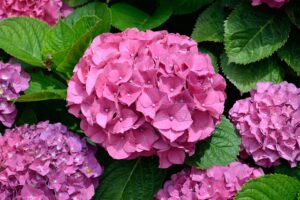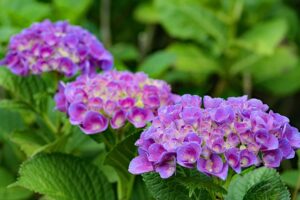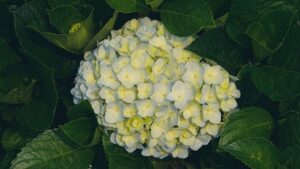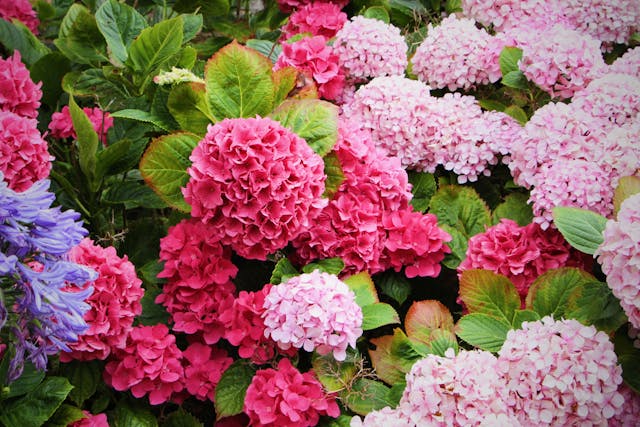Hydrangea trees are captivating ornamental plants known for their stunning blooms and graceful appearance. These unique trees can be grown in gardens and containers, offering versatility and charm to any outdoor space. In this comprehensive guide, we will delve into the world of hydrangea trees, covering everything from propagation techniques to potting and care tips.
About Hydrangea Trees

Hydrangea trees, also known as standard hydrangeas or tree-form hydrangeas, are a cultivated form of hydrangea shrubs trained to grow with a single trunk. They produce large, showy flower clusters that can range in colour from white and pink to blue and purple, depending on the soil pH and variety.
How to Grow a Hydrangea Tree in a Pot
Growing a hydrangea tree in a pot is an excellent option for gardeners with limited space or those looking to add a striking focal point to patios, balconies, or porches. Here’s how to do it:
1. Choose the Right Container:
Select a large, sturdy pot with drainage holes to allow excess water to escape. Hydrangea trees have deep root systems, so opt for a container that is at least 18-24 inches in diameter.
2. Use Quality Potting Mix:
Fill the container with a well-draining potting mix suitable for hydrangeas. You can also add organic matter like compost to improve soil fertility and moisture retention.
3. Planting the Hydrangea Tree:
Carefully remove the hydrangea tree from its nursery container and place it in the center of the pot. Ensure that the top of the root ball is level with the soil surface.
4. Watering and Sunlight:
Hydrangea trees prefer partial shade, especially during hot summer months. Water the tree regularly to keep the soil consistently moist but not waterlogged.
5. Fertilizing:
Feed your hydrangea tree with a balanced fertilizer formulated for flowering plants. Apply according to package instructions during the growing season to promote healthy growth and abundant blooms.
6. Pruning and Maintenance:
Remove spent flowers and dead or damaged branches as needed to maintain a tidy appearance. Prune in late winter or early spring to encourage new growth and flowering.
How to Propagate Hydrangea Trees
Propagating hydrangea trees can be done through various methods, including stem cuttings and layering. Here’s how to propagate hydrangea trees from cuttings:
1. Selecting Cuttings:
Choose healthy, non-flowering stems from the current season’s growth. Cut 6-8 inch-long sections, ensuring each cutting has at least two leaf nodes.
2. Preparing the Cuttings:
Remove the lower leaves from the cuttings, leaving only a few leaves at the top. Dip the cut end in rooting hormone powder to promote root development.
3. Planting the Cuttings:
Insert the cuttings into a container filled with moistened potting mix. Keep the container in a warm, bright location but out of direct sunlight.
4. Rooting Process:
Make the cuttings regularly to maintain humidity and moisten the soil. Roots should start to develop within 4-6 weeks.
5. Transplanting:
Once roots have formed, carefully transplant the rooted cuttings into individual pots or directly into the garden. Water thoroughly and continue to care for the new plants as they are established.
How Do You Propagate Hydrangea Trees through Layering

Layering is another effective method of propagating hydrangea trees. Here’s how to do it:
1. Identify a Suitable Branch:
Choose a healthy, flexible branch that can be easily bent and buried.
2. Preparation:
Make a small wound on the underside of the branch where it will come in contact with the soil. Dust the wound with rooting hormone powder.
3. Burying the Branch:
Gently bend the wounded portion of the branch downward and bury it in the soil. Anchor it in place with a small rock or wire.
4. Root Formation:
Keep the soil consistently moist around the buried portion of the branch. Roots should develop within a few months.
5. Separation:
Once roots have formed, carefully cut the branch from the parent plant and transplant it into its desired location.
Tips for Caring for Hydrangea Trees
Watering: Hydrangea trees prefer consistently moist soil. Water deeply during dry periods, especially in containers.
Pruning: Remove dead or weak branches in late winter or early spring to promote healthy growth and flowering.
Soil pH: Adjust soil pH to influence flower color. Acidic soil produces blue flowers, while alkaline soil results in pink flowers.
Protection from Frost: Provide winter protection for hydrangea trees in colder climates by mulching around the base of the tree.

Conclusion
Hydrangea trees are elegant additions to any garden or outdoor space, offering beautiful blooms and versatility in both garden beds and containers. By following these propagation, potting, and care tips, you can successfully grow and enjoy the beauty of hydrangea trees in your own landscape. Experiment with different varieties and techniques to create a stunning display of these beloved flowering trees. Whether you’re a novice gardener or a seasoned enthusiast, cultivating hydrangea trees is sure to bring joy and beauty to your outdoor environment.





